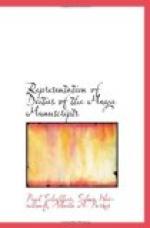[10-1] See Plate for representations of the gods, A-P
A distinguishing ornament of the death-god consists of globular bells or rattles, which he wears on his hands and feet, on his collar and as a head ornament. As can be distinctly seen in Dr. 11a, they are fastened with bands wound around the forearm and around the leg; in Dr. 15c these bells are black.
Among the symbols of the death-god a cross of two bones should be mentioned, which is also found in the Mexican manuscripts. This cross of bones seems to occur once among the written characters as a hieroglyph and then in combination with a number: Tro. 10.* The figure [Death-god symbol] is also a frequent symbol of the death-god. Its significance is still uncertain, but it also occurs among the hieroglyphs as a death-sign and as a sign for the day Cimi (death).
The hieroglyphs of the death-god have been positively determined (see Figs. 1 to 4). Figs. 1 and 2 are the forms of the Dresden manuscript and Figs. 3 and 4 are those of the Madrid manuscript. God A is almost always distinguished by two hieroglyphs, namely Figs. 1 and 2 or 3 and 4. Moreover the hieroglyphs are always the same, have scarcely any variants. Even in Dr. 9c, where the deity is represented as feminine, there are no variations which might denote the change of sex. The hieroglyphs consist chiefly of the head of a corpse with closed eyes, and of a skull. The design in front of the skull in Figs. 2 and 4 and under it in Fig. 3 is a sacrificial knife of flint, which was used in slaying the sacrifices, and is also frequently pictured in the Aztec manuscripts. The dots under Fig. 1 are probably intended to represent blood.




